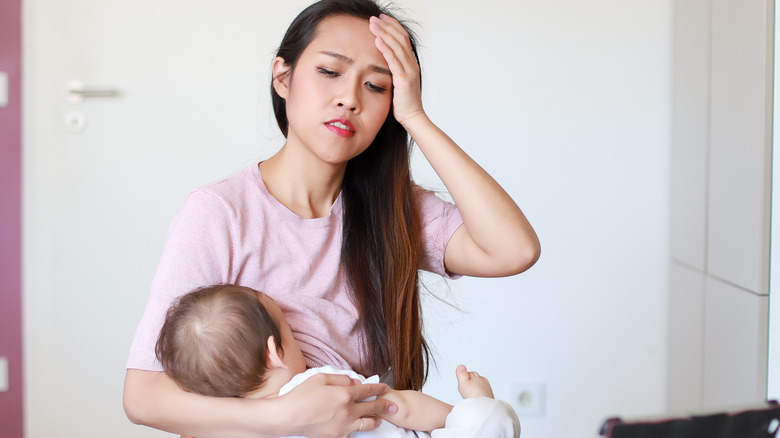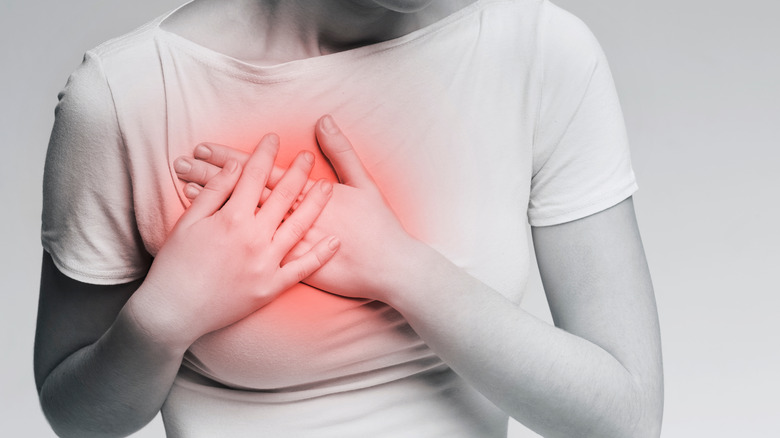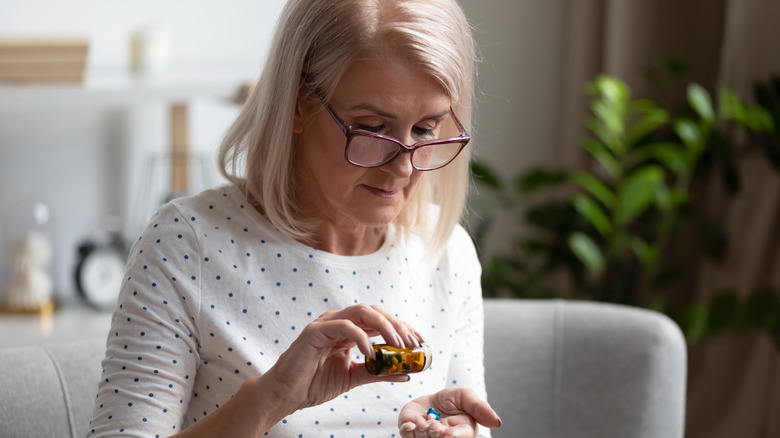What Is Mastitis And How Can You Treat It?
When you're new at breastfeeding, the process can be painful, what with the breasts becoming engorged with milk and the baby latching on. It is, at least temporarily, no walk in the park. Over time, though, both mom and baby can adjust. Sometimes, however, there are bumps along the road to that experience. Mastitis is one such "bump," so to speak.
Mastitis is a breast infection that occurs when harmful bacteria get trapped in the breast tissue, usually after a milk duct becomes clogged and doesn't empty completely during feedings. The stagnant milk creates a breeding ground for bacteria (via Mayo Clinic). Bacteria from your skin or your baby's mouth can enter the breast through a crack in the nipple or via an opening in a milk duct, according to What to Expect.
Mastitis usually happens during the first six weeks after birth and usually affects just one breast. However, it's not impossible to develop it after many months or in both breasts at the same time. It's also not impossible to develop it if you're not nursing (more on that later). Symptoms include swelling, pain, and redness of the breast, fever, flu-like symptoms such as chills, exhaustion, and pain or a burning sensation when nursing, per Mayo Clinic. You may also feel a hard lump or thickness in the breast, which is likely the clogged duct.
What causes mastitis and how to treat it
Although any nursing mom can be affected, you are more prone to develop mastitis if you've had it before. Going too long without draining the breasts can lead to a clogged duct, so if you've missed a feeding or pumping session it can raise your risk. If your baby has a poor latch or prefers to nurse from one breast or the other, it can make it difficult for your baby to empty both breasts fully. Tight bras or even wearing a seatbelt across your breasts can also make you more prone to mastitis. Additionally, if you are overly tired or stressed, not eating well, or smoking, you may be more likely to experience mastitis, according to What to Expect.
It's important to call your doctor right away when you notice symptoms of mastitis, which can come on quite suddenly. You may need antibiotics to squelch the infection (per WebMD) and pain relievers to help you feel better (via What to Expect). Nursing with mastitis, even while you're being treated, is safe for your baby.
To relieve pain from nursing and encourage milk flow, use warm compresses before a feeding or massage your breast while your baby nurses. Consider also going braless or wearing a loose-fitting underwire-free bra, to keep any extra pressure off your breasts. Be sure to drink at least 10 glasses of water daily.
Mastitis doesn't only affect women who are breastfeeding
Although mastitis most commonly occurs in breastfeeding moms, it has also been known to affect women who aren't breastfeeding. Postmenopausal women may suffer from mastitis associated with chronic inflammation of the milk ducts below the nipple, according to WebMD. The milk ducts may become clogged with dead skin cells and debris due to hormonal changes and render the breast more vulnerable to bacterial infection. Unfortunately, infections tend to recur after antibiotic treatment.
Moreover, it can affect women before menopause. "Anyone who has had trauma or chafing to the nipple that creates an open environment from the outside to the ducts, including a nipple piercing, can develop mastitis and inflammation of the breast," breast surgeon Ashley Simpson told the Cleveland Clinic. Nipple piercings also increase your risk of developing mastitis by approximately 20% (via Patient Care). Those who develop mastitis symptoms often delay seeking medical care because they don't want their piercing removed or they don't want to be chided by the doctor. But it's important to see a physician no matter what caused the infection.



